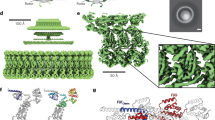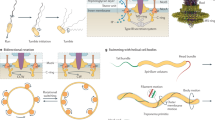Abstract
THERE are two simple ways in which the observed screw-like propulsive motion of bacterial flagella can be understood. Either, first, the flagellum is like a rigid corkscrew rotating in a sort of journal bearing in the cell wall (hypothesis A) or, second, the flagellum is firmly attached to the cell wall and moves by the propagation of helical waves (hypothesis B).
This is a preview of subscription content, access via your institution
Access options
Subscribe to this journal
Receive 51 print issues and online access
$199.00 per year
only $3.90 per issue
Buy this article
- Purchase on SpringerLink
- Instant access to full article PDF
Prices may be subject to local taxes which are calculated during checkout
Similar content being viewed by others
References
Berg, H. C., and Anderson, R. A., Nature, 245, 380–382 (1973).
Di Pierro, J. M., and Doetsch, R. N., Can. J. Microbiol., 14, 487–489 (1968).
Asakura, S., Adv. Biophys., 1, 99–155 (1970).
Green, N. M., Adv. Immun., 11, 1–30 (1969).
Padlan, E. A., Segal, D. M., Spande, T. F., Davies, D. R., Rudikoff, S., and Potter, M., Nature new Biol., 245, 165–167 (1973).
Klug, A., Symp. int. Soc. Cell Biol., 6, 1–18 (1967).
Author information
Authors and Affiliations
Rights and permissions
About this article
Cite this article
CALLADINE, C. Bacteria can swim without rotating flagellar filaments. Nature 249, 385 (1974). https://doi.org/10.1038/249385a0
Received:
Issue date:
DOI: https://doi.org/10.1038/249385a0
This article is cited by
-
Bacterial behaviour
Nature (1975)
-
Feinstrukturanalyse der komplexen Gei�eln von Rhizobium lupini H 13-3
Archives of Microbiology (1974)



